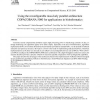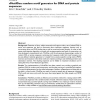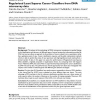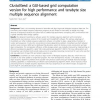2381 search results - page 24 / 477 » Take Advantage of the Computing Power of DNA Computers |
PROCEDIA
2010
13 years 3 months ago
2010
Currently several computational problems require high processing power to handle huge amounts of data, although underlying core algorithms appear to be rather simple. Especially i...
BMCBI
2007
13 years 8 months ago
2007
Background: Detection of short, subtle conserved motif regions within a set of related DNA or amino acid sequences can lead to discoveries about important regulatory domains such ...
BMCBI
2005
13 years 8 months ago
2005
Background: The advent of the technology of DNA microarrays constitutes an epochal change in the classification and discovery of different types of cancer because the information ...
BMCBI
2010
13 years 8 months ago
2010
Background: There is an increasing demand to assemble and align large-scale biological sequence data sets. The commonly used multiple sequence alignment programs are still limited...
BMCBI
2007
13 years 8 months ago
2007
Background: Gene Set Enrichment Analysis (GSEA) is a computational method for the statistical evaluation of sorted lists of genes or proteins. Originally GSEA was developed for in...




